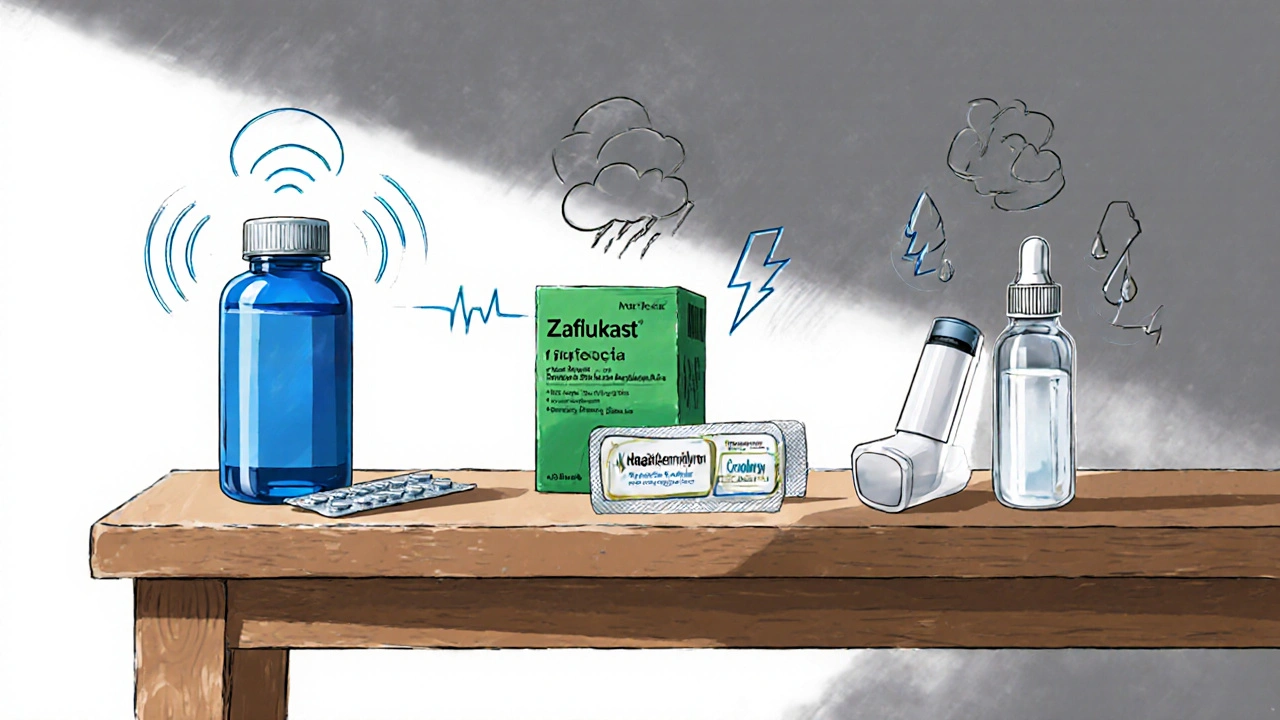Asthma Medication Selector
Let's find the right asthma medication for you
Answer a few questions about your symptoms, medical history, and preferences to get a personalized recommendation based on the latest clinical evidence.
If you’ve been prescribed Montair, you’re probably wondering how it stacks up against other options for asthma and allergic rhinitis. This guide breaks down the science, side‑effect profile, and practical considerations so you can decide whether Montair is right for you or if another drug might fit better.
What is Montair (Montelukast) and how does it work?
Montair is the brand name for the oral leukotriene‑receptor antagonist montelukast, marketed in many countries for the maintenance treatment of asthma and the relief of seasonal allergic rhinitis. By blocking cysteinyl‑leukotriene receptors (CysLT1) in the airways, Montair prevents the inflammatory cascade that leads to bronchoconstriction, mucus production, and airway edema. The result is smoother breathing, fewer nighttime symptoms, and a reduced need for rescue inhalers.
Montelukast is taken once daily, typically at bedtime, and reaches steady‑state concentrations within 3‑5 days. Because it works systemically rather than locally, it can benefit patients with both asthma and concurrent allergic rhinitis-a common overlap.
Key alternatives to Montair
When clinicians consider a leukotriene‑receptor antagonist (LTRA), they usually look at a handful of approved drugs. Below are the most relevant alternatives, each with its own brand name and nuance.
- Singulair is the U.S. brand of montelukast, identical in active ingredient but often priced differently depending on the pharmacy.
- Zafirlukast (brand name Accolate) is another LTRA that binds the same CysLT1 receptor but has a shorter half‑life, requiring twice‑daily dosing.
- Pranlukast (brand name Onon) is approved primarily in Japan and some Asian markets; it’s less commonly used in Western practice.
- Cromolyn sodium (brand name Nasalcrom for nasal spray, and various inhalation forms) works by stabilising mast cells, offering a non‑steroidal alternative for mild asthma.
- Fluticasone propionate (inhaled corticosteroid, e.g., Flovent) targets airway inflammation directly and is the first‑line preventive therapy for persistent asthma.
Side‑effect profiles: What to watch for
All drugs carry risks, and understanding them helps you and your clinician weigh benefits against drawbacks.
| Adverse event | Montair (Montelukast) | Zafirlukast | Pranlukast | Cromolyn sodium | Fluticasone (ICS) |
|---|---|---|---|---|---|
| Headache | Common (≈10‑15%) | Common | Rare | Rare | Uncommon |
| Neuropsychiatric effects (mood changes, nightmares) | Rare but serious (≈0.5%) | Rare | Very rare | None reported | None reported |
| Upper respiratory infection | Occasional | Occasional | Occasional | Common | Common |
| Oral thrush (candida) | None | None | None | None | Common (inhaled) |
| GI upset | Mild | Moderate | Moderate | None | Rare |
Montair tends to be well‑tolerated, but the FDA has issued a boxed warning about rare neuropsychiatric events, prompting clinicians to monitor mood changes especially in adolescents.

Effectiveness: How does Montair compare?
Large‑scale meta‑analyses (e.g., a 2022 Cochrane review of 72 trials) show that LTRAs, including Montair, reduce the risk of asthma exacerbations by roughly 15% compared with placebo. However, inhaled corticosteroids (ICS) like Fluticasone propionate cut exacerbations by up to 40% and improve lung‑function tests more robustly.
When compared head‑to‑head, Montair and Zafirlukast provide similar improvements in peak expiratory flow (PEF) and symptom scores, but Zafirlukast’s twice‑daily dosing can affect adherence.
For patients with milder, exercise‑induced asthma, Montair often performs on par with short‑acting β‑agonists (SABAs) used prophylactically, offering a convenient once‑daily pill instead of an inhaler.
Choosing the right therapy: Patient‑focused scenarios
- Scenario 1 - Persistent asthma needing step‑2 control: Guidelines (GINA 2023) recommend an inhaled corticosteroid as first‑line. Montair can be added if adherence to inhalers is problematic or if the patient also suffers from allergic rhinitis.
- Scenario 2 - Mild intermittent asthma + allergic rhinitis: Montair alone often suffices because it tackles both airway inflammation and nasal symptoms.
- Scenario 3 - Children with asthma: Montair is approved for ages 6 and up. For younger kids, cromolyn sodium inhalation or low‑dose ICS are preferred.
- Scenario 4 - History of mood disorders: Given the rare but reported neuropsychiatric effects, clinicians may avoid Montair and opt for cromolyn or low‑dose ICS.
- Scenario 5 - Cost‑sensitive patients: Generic montelukast (often found as “Montair generic”) is usually cheaper than brand‑name Singulair or inhaled steroids, making it an attractive first step for many insurance plans.

Cost and accessibility
In the United States, a 30‑day supply of generic Montair costs about $15‑$25, while brand‑name Singulair hovers near $60. Zafirlukast is more expensive ($70‑$90) and rarely covered by insurers. Inhaled corticosteroids vary widely; generic fluticasone can be $30‑$45, but device costs (inhaler) add $10‑$20.
Internationally, Pranlukast is stocked in Japan and parts of Southeast Asia at a price comparable to generic montelukast, but it may not be approved in the U.S. or Europe.
When budgeting, consider pharmacy discount programs, manufacturer coupons, or bulk‑purchase options. Many insurers require step‑therapy, meaning they’ll try a generic LTRA before approving an inhaled steroid.
FAQs
Can I take Montair if I have a cold?
Montair does not treat viral infections, but you can continue it during a cold if you’re already on the medication. It may help lessen cough caused by airway inflammation, but it won’t cure the cold.
How long does it take for Montair to start working?
Most patients notice symptom improvement within 3‑5 days, though full steady‑state effect may take up to two weeks.
Is Montair safe during pregnancy?
Category B evidence suggests no major fetal risk, but doctors usually prefer inhaled steroids for pregnant asthma patients unless LTRA is specifically indicated.
Can I switch from Singulair to Montair?
Yes. Both contain the same active ingredient, so the switch is essentially a change of brand. Verify dosing and insurance coverage with your pharmacy.
What should I do if I experience mood changes on Montair?
Contact your physician immediately. They may pause the medication, switch to an alternative LTRA, or move to an inhaled steroid regimen.
Are there any food or drug interactions with Montair?
Montair has minimal interactions, but strong CYP3A4 inhibitors (e.g., ketoconazole) can raise its levels slightly. Always inform your doctor about other prescriptions.
Bottom line
Montair (montelukast) offers a convenient, once‑daily oral option for patients with mild‑to‑moderate asthma and concurrent allergic rhinitis. It shines when inhaler adherence is an issue or when cost constraints limit access to inhaled steroids. However, for patients needing stronger inflammation control, especially those with frequent exacerbations, inhaled corticosteroids remain the gold standard. Weigh side‑effect profiles, dosing convenience, and insurance coverage to pick the best fit for your lifestyle.





Jinny Shin
23 October 2025 - 16:15 PM
One must approach the Montair discourse with the gravitas it deserves, lest we squander the nuance of pharmacologic elegance. The guide, while thorough, feels as if it were penned by a committee of the merely competent. I find the comparison to inhaled corticosteroids rather pedestrian, considering the subtleties of leukotriene pathways. Still, the cost analysis is commendably precise, a rare virtue in medical journalism. Ultimately, the reader is left to navigate a maze of data with only a flickering torch.
deepak tanwar
24 October 2025 - 20:02 PM
It appears the author has opted for a conventional overview, neglecting to interrogate the underlying methodological robustness of the cited meta‑analyses. One must ask whether the statistical heterogeneity was adequately addressed, especially given the diverse patient populations. Moreover, the narrative omits a critical appraisal of the FDA's boxed warning implications on clinical decision‑making. The briefing would benefit from a deeper exploration of pharmacovigilance data rather than a superficial cost comparison. In its current form, the piece serves more as a marketing summary than a scholarly critique.
Simon Waters
25 October 2025 - 23:48 PM
Well, the guide looks fine but you never know who’s really pulling the strings behind the scenes. Some say the pharma giants are feeding us half‑truths to keep us buying brand names. The info about generic Montair might be downplayed on purpose. Keep an eye out for hidden agendas.
Vikas Kumar
27 October 2025 - 02:35 AM
India produces affordable generic Montair, and we should champion our own pharma over foreign imports.
Celeste Flynn
28 October 2025 - 06:22 AM
Montair is a solid option for many patients especially when inhaler technique is an issue. The drug works by blocking leukotriene receptors which can help both asthma and allergic rhinitis you can usually start seeing improvement within a week of consistent use. It's taken once daily at night which fits nicely into most routines and avoids the hassle of multiple doses. For those concerned about side effects the most common issues are mild headaches and occasional stomach upset but serious neuropsychiatric events are rare though they should be monitored especially in teens. Costwise generic montelukast tends to be cheap compared to brand name Singulair and inhaled steroids which can run high especially when you factor in the inhaler devices. If you're on a tight budget the savings can be significant and many insurance plans will prefer the generic first. In terms of efficacy it's not as powerful as high‑dose inhaled corticosteroids for severe asthma but it holds its own in mild to moderate cases and can reduce the need for rescue inhalers. Some patients also appreciate that Montair can help with seasonal allergy symptoms at the same time eliminating the need for an extra nasal spray. While the guide mentions that montelukast has minimal drug interactions you should still inform your doctor about any strong CYP3A4 inhibitors like ketoconazole they can raise blood levels slightly. Pregnant patients should discuss alternatives with their physician although current data suggest Montair is relatively safe in pregnancy. Finally remember that any change in medication should be done under medical supervision and you should not abruptly stop the drug without consulting your healthcare provider.
Shan Reddy
29 October 2025 - 10:08 AM
Great rundown, Celeste. I’d add that adherence improves when patients don’t have to carry an inhaler around. Also, checking the pharmacy’s discount program can shave off a few dollars.
CASEY PERRY
30 October 2025 - 13:55 PM
From a pharmacoeconomic perspective, Montair’s cost‑effectiveness ratio aligns favorably with first‑line LTRAs, especially when factoring in adherence metrics and reduced exacerbation frequency. The therapeutic index remains acceptable within the standard dosing parameters.
Naomi Shimberg
31 October 2025 - 17:42 PM
While the previous comment extols Montair’s economic merits, one must also consider the broader implications of endorsing a monotherapy that may obscure the necessity for inhaled corticosteroids in severe phenotypes. The data supporting sole reliance on LTRAs remain equivocal, and the risk‑benefit calculus should be rigorously applied. Moreover, the presumption that cost alone dictates therapeutic hierarchy undermines evidence‑based practice. It is incumbent upon clinicians to prioritize clinical outcomes over fiscal considerations.